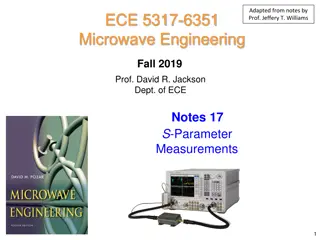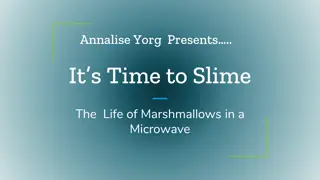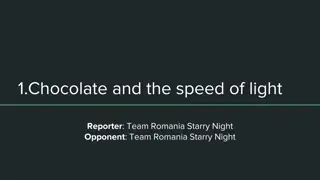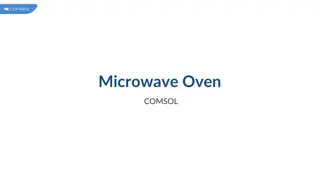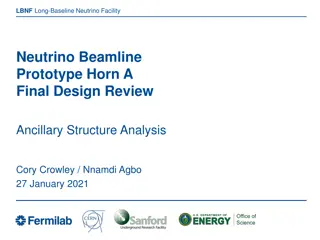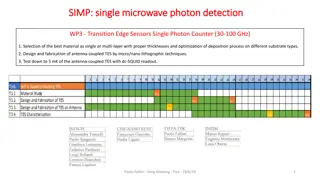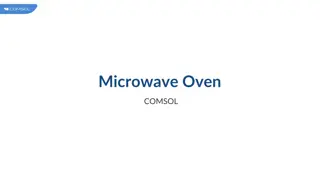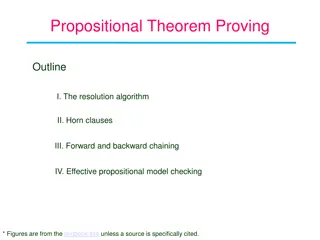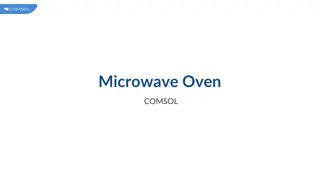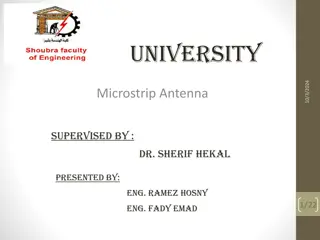Understanding Horn Antennas in Microwave Technology
Horn antennas are integral in microwave technology, offering high gain, low VSWR, and wide bandwidth. Widely used for radio astronomy, satellite communication, and more, horns play a crucial role in various applications. Learn about the design, characteristics, and radiation properties of horn antennas through insightful descriptions and visuals from the Antenna and Microwave Laboratory at Babol Noshirvani University of Technology in Iran.
Download Presentation

Please find below an Image/Link to download the presentation.
The content on the website is provided AS IS for your information and personal use only. It may not be sold, licensed, or shared on other websites without obtaining consent from the author. Download presentation by click this link. If you encounter any issues during the download, it is possible that the publisher has removed the file from their server.
E N D
Presentation Transcript
In the name of God Antenna and Microwave Laboratory Babol Noshirvani University of Technology, Iran Horn Antenna Antenna and Microwave Laboratory Babol Noshirvani University of Technology zakeri@nit.ac.ir
Horn Antennas One of the simplest and probably the most widely used microwave antenna is the horn. its revival began in the late 1930s from the interest in microwaves and waveguide transmission lines during the period of World War II Characteristics: High gain Low VSWR Relatively Wide Bandwidth Low weight simplicity in construction ease of excitation The horn is nothing more than a hollow pipe of different cross sections, which has been tapered (flared) to a larger opening. The type, direction, and amount of taper (flare) can have a profound effect on the overall performance of the element as a radiator Antenna and Microwave Laboratory Babol Noshirvani University of Technology zakeri@nit.ac.ir
Horn Antennas Horn is widely used as a feed element for large radio astronomy, satellite, tracking, and communication dishes. It is a common element of phased arrays and serves as a universal standard for calibration and gain measurements of other high gain antennas. They take many different forms as: Antenna and Microwave Laboratory Babol Noshirvani University of Technology zakeri@nit.ac.ir
Horn Antennas The horn is nothing more than a hollow pipe of different cross sections, which has been tapered (flared) to a larger opening. The type, direction, and amount of taper (flare) can have a profound effect on the overall performance of the element as a radiator Antenna and Microwave Laboratory Babol Noshirvani University of Technology zakeri@nit.ac.ir
E-Plane Sectoral Horn Antennas Aperture Fields: Horn can be treated as an aperture antenna. To find its radiation characteristics, equivalent principle techniques can be utilized. Fields within horn can be expressed in terms of cylindrical TE and TM wave functions. Fields can be found using: Difference in path of travel designated as: Which is referred to as spherical phase term. Example: an horn having a=0.5 , b=0.25 , b1=2.75 so that maximum phase deviation at aperture of horn is 56.72o. Find Sectoralangle Using Binomial Expansion: Antenna and Microwave Laboratory Babol Noshirvani University of Technology zakeri@nit.ac.ir
E-Plane Sectoral Horn Antennas Where: Antenna and Microwave Laboratory Babol Noshirvani University of Technology zakeri@nit.ac.ir
E-Plane Sectoral Horn Antennas E-Plane Patterns: Antenna and Microwave Laboratory Babol Noshirvani University of Technology zakeri@nit.ac.ir
H-Plane Sectoral Horn Antennas H-Plane Patterns: Antenna and Microwave Laboratory Babol Noshirvani University of Technology zakeri@nit.ac.ir
Pyramidal Horn Antennas Pyramidal Horns: Most widely used horn is one which is flared in both directions as: Its radiation characteristics are a combination of E and H plane Sectoral horns. Aperture fields: Equivalent currents: Radiation fields: Antenna and Microwave Laboratory Babol Noshirvani University of Technology zakeri@nit.ac.ir
Pyramidal Horn Radiation fields (cont.): It can be shown: Far zone fields: Antenna and Microwave Laboratory Babol Noshirvani University of Technology zakeri@nit.ac.ir
Pyramidal Horn Radiation fields (cont.): Antenna and Microwave Laboratory Babol Noshirvani University of Technology zakeri@nit.ac.ir
Pyramidal Horn Radiation fields (cont.): Antenna and Microwave Laboratory Babol Noshirvani University of Technology zakeri@nit.ac.ir
Pyramidal Horn Antenna and Microwave Laboratory Babol Noshirvani University of Technology zakeri@nit.ac.ir
Pyramidal Horn A commercial standard gain X-band (8.2 12.4 GHz) horn: It is a lightweight precision horn antenna for: Standard for calibrating other antennas. Feed for reflectors and lenses. Pickup (probe) horn for sampling power. Receiving and/or transmitting antenna. Antenna and Microwave Laboratory Babol Noshirvani University of Technology zakeri@nit.ac.ir
Corrugated Horn Corrugated Horn: A large emphasis on horn antenna research in 1960s was: Reduce spillover efficiency. Cross-polarization losses. Increase aperture efficiencies of large reflectors used in radio astronomy and satellite. In 1970s, high-efficiency and rotationally symmetric antennas were needed in microwave radiometry. Using conventional feeds, aperture efficiencies of 50 60% were obtained. However, efficiencies of order of 75 80% can be obtained with improved feed systems utilizing corrugated horns. Antenna pattern structure in back lobe region is strongly influenced by diffractions from edges, especially from those that are perpendicular Antenna and Microwave Laboratory Babol Noshirvani University of Technology zakeri@nit.ac.ir
Corrugated Horn Antenna and Microwave Laboratory Babol Noshirvani University of Technology zakeri@nit.ac.ir
Stack of sectoral feed horns for air search radar antenna 50 ft. Holmdel horn antenna at Bell labs in Holmdel, New Jersey, USA, with which Arno Penzias and Robert Wilson discovered cosmic microwave background radiation in 1964. zakeri@nit.ac.ir 17 Antenna and Microwave Laboratory Babol Noshirvani University of Technology
Feeding of Horn zakeri@nit.ac.ir 18 Antenna and Microwave Laboratory Babol Noshirvani University of Technology
Now, Let`s get familiar with a brand new software: Antenna Magus Antenna and Microwave Laboratory Babol Noshirvani University of Technology zakeri@nit.ac.ir
Go to CST and simulate a example And complete the work sheet Antenna and Microwave Laboratory Babol Noshirvani University of Technology zakeri@nit.ac.ir
Worksheet Please complete the work sheet to your example: Frequency band : The figure of antenna in CST : The of size antenna in and in cm/mm : S11 : (set Z0=75 ohm) Zin (Re and Im) in CST : Surface Current (phase=0 deg) : linear 3D Power Pattern in CST : 2D Power Pattern for theory & CST : HPBW for theory & CST : Antenna and Microwave Laboratory Babol Noshirvani University of Technology zakeri@nit.ac.ir







